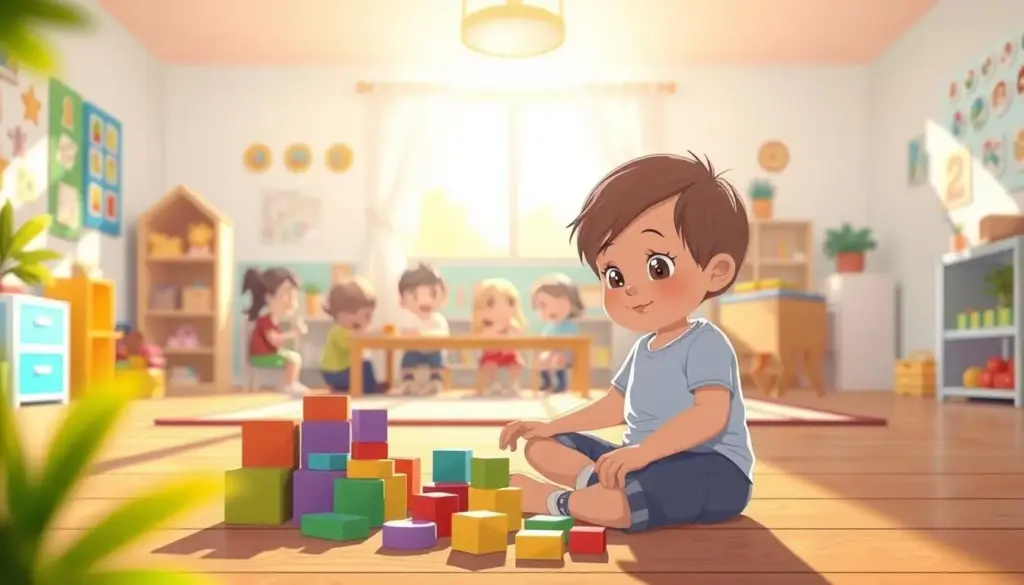Effective parenting is more than just love. It’s about guiding and disciplining too. It’s about creating a place where kids can grow and succeed.
Using positive parenting techniques helps kids behave well and strengthens family ties. It teaches them important life skills by example, not just by saying so.
Good parenting strategies mix clear communication, steady discipline, and emotional support. These steps help kids become confident and capable.
Key Takeaways
- Positive parenting techniques foster a supportive environment.
- Effective communication is crucial for successful parenting.
- Consistent discipline helps children understand boundaries.
- Emotional support is vital for a child’s development.
- Parenting done right involves a combination of love, guidance, and discipline.
The Science Behind Child Development
Understanding child development is key for parents wanting to create a caring home. It covers physical, emotional, and mental growth from birth to teen years. Knowing the science helps parents meet their child’s needs and handle parenting’s ups and downs.
Developmental Milestones by Age
Children grow at their own pace, but they hit certain milestones around the same time. For example, most kids start walking on their own between 12 and 14 months. Knowing these milestones helps spot any delays early on.
How Brain Development Affects Behavior
Brain growth is vital for a child’s behavior and emotional control. Studies show that loving parenting boosts brain areas linked to feelings and thinking in teens.
“Research reveals the power of positive parenting,” highlighting its impact on brain regions associated with emotional regulation and cognitive function.
The brain’s growth shapes a child’s actions, feelings, and thinking skills. As the brain matures, kids get better at handling their emotions and actions.
Individual Temperaments and Learning Styles
Every child is born with their own personality and learning way. These traits shape how they see the world and react to parenting.
| Temperament Type | Characteristics | Parenting Strategies |
|---|---|---|
| Easy-going | Adaptable, positive mood | Positive reinforcement, consistent routines |
| Sensitive | Emotionally reactive, sensitive to environment | Gentle discipline, emotional validation |
| Feisty | Strong-willed, resistant to change | Clear boundaries, patient communication |

The Foundation of Parenting Done Right
Parenting starts with key principles that help children grow in a healthy way. It’s about creating a nurturing environment.
Creating a secure attachment bond between parent and child is crucial. This bond gives children a sense of safety and security. It’s vital for their emotional and psychological growth. Techniques like MIND, BODY AND SOUL TIME® Connection (MBST) help by encouraging meaningful interactions.
Creating a Secure Attachment Bond
A secure bond is built on consistent, responsive, and sensitive parenting. It means being in tune with your child’s needs and responding to them. It also means doing activities that help you connect and understand each other better.

Establishing Consistency and Predictable Routines
Consistency and routines are key for children’s development. They help children feel secure and develop self-regulation skills. Clear routines and consistent rules create a stable environment.
For instance, a consistent bedtime routine signals sleep time. It makes bedtime easier for your child. Consistent rules and consequences also help children understand boundaries and behave well.
Modeling the Behaviors You Want to See
Children learn a lot from watching their parents. Modeling the behaviors you want to see in your child is a powerful strategy. Show respect, kindness, and responsibility. Also, manage your emotions well.
By being mindful of your actions, you can greatly influence your child’s development. It’s also key to apologize when you make mistakes. This shows accountability and respect for others’ feelings.
Effective Parent-Child Communication Skills
Good communication between parents and kids is key to a strong bond. It’s not just about talking; it’s about making sure both feel heard and understood.
Teaching your child how to communicate well is crucial. It helps them express themselves, understand others, and deal with social challenges.
Active Listening Techniques That Work
Active listening is vital for good communication. It means giving your child your full attention, getting their point of view, and responding thoughtfully.
- Maintain eye contact to show you’re engaged.
- Use verbal and non-verbal cues to show you’re listening.
- Reflect your child’s words to ensure understanding.
- Avoid interrupting and let your child finish speaking.
Using these active listening techniques can make your bond stronger. It helps your child feel secure and understood.
Age-Appropriate Conversation Strategies
As kids grow, so does their ability to talk. Using conversation strategies that fit their age helps you communicate better at every stage.
| Age Group | Conversation Strategies |
|---|---|
| Infants/Toddlers | Use simple language, respond to coos and babbles. |
| Preschoolers | Ask open-ended questions, encourage storytelling. |
| School-Age Children | Discuss their interests, use complex sentences. |
Adjusting how you talk to your child based on their age can improve your relationship. It also helps them learn important communication skills.
Navigating Difficult Topics with Confidence
Talking about tough subjects with your child can be scary. But it’s important for their growth. Being confident and sensitive helps them handle complex issues.
Here are some tips for talking about hard topics:
- Choose the right time and place for the conversation.
- Be honest and clear in your explanation.
- Listen to your child’s concerns and questions.
- Provide reassurance and support.
Tackling tough topics with care and confidence builds resilience in your child. It helps them understand the world better.
Positive Parenting Techniques That Build Cooperation
Positive parenting helps create a space where everyone respects each other. It focuses on good behavior and stops bad ones. This makes family life better.
At the heart of positive parenting is setting clear and reasonable boundaries. Kids do better when they know what’s expected. Parents should clearly state rules and apply consequences fairly.
Setting Clear and Reasonable Boundaries
Boundaries teach kids how to handle the world. Clear rules and consequences help them see their actions’ effects. This leads to better choices.
For example, a table with household rules and consequences is very helpful:
| Rule | Consequence for Breaking Rule | Positive Reinforcement for Following Rule |
|---|---|---|
| Clean up toys after playtime | Loss of playtime the next day | Praise and extra storytime |
| Be respectful to others | Apology and restitution | Verbal praise and special privileges |
Natural and Logical Consequences vs. Punishment
Positive parenting uses natural and logical consequences instead of punishment. This method teaches kids to be accountable. It links the consequence directly to the misbehavior.
For example, if a child doesn’t wear a coat on a cold day, they might get cold. This teaches them to wear a coat without punishment.
Positive Reinforcement Strategies
Positive reinforcement encourages good behavior. It rewards kids for positive actions. This motivates them to choose good over bad.
Verbal praise, rewards, and special privileges are great ways to do this. For instance, a reward chart for homework can help kids study better.
By using clear boundaries, natural consequences, and positive reinforcement, parents can support their kids. This creates a place where cooperation and positive growth thrive.
Nurturing Emotional Intelligence in Children
Teaching emotional intelligence is crucial for a child’s happiness. It includes skills like recognizing emotions, controlling oneself, and feeling for others.
Teaching Emotion Recognition and Vocabulary
It’s key to help kids understand their feelings. This means teaching them a wide range of emotional words. Parents can do this by naming their child’s emotions and encouraging them to share theirs.
For example, if a child is upset, say, “You seem angry right now. It’s okay to feel angry.” This helps them know and say how they feel.
Developing Self-Regulation and Coping Skills
Self-regulation means managing one’s feelings and actions. Kids with good self-regulation skills deal better with stress. Parents can teach them to handle tough times by showing them ways to cope, like deep breathing or counting.
For instance, during a tantrum, a parent can show deep breathing, saying, “Let’s take a deep breath together. Inhale… exhale…” This helps the child calm down and manage their feelings.
Building Empathy and Social Awareness
Empathy lets us understand and share others’ feelings. Teaching kids to see things from another’s point of view is important. Parents can do this by talking about how others might feel in different situations.
Role-playing is also helpful. For example, acting out a scenario where a friend feels left out can teach a child about the value of empathy and inclusion.
| Skill | Description | Example Activity |
|---|---|---|
| Emotion Recognition | Identifying and understanding one’s emotions | Labeling emotions during a story |
| Self-Regulation | Managing one’s emotions and behaviors | Deep breathing exercises |
| Empathy | Understanding and sharing the feelings of others | Role-playing different social scenarios |
Age-Specific Strategies for Raising Children Successfully
Good parenting means knowing and using strategies that fit each child’s age. As kids grow, their needs change. Parents must adjust their ways to help them grow well.
Infants and Toddlers (0-3 years)
For babies and toddlers, building a strong bond is key. This means being there for them, creating a caring space, and doing things that help their brains grow.
- Answer their sounds to help them learn to talk.
- Do skin-to-skin contact to help them feel safe.
- Make their world fun with toys and things to do.
Preschool and Early Elementary (4-8 years)
In preschool and early elementary, teaching kids how to get along and explore is important. Parents can help by showing good behavior, setting rules, and helping them meet others.
- Show them how to be kind and work together.
- Help them learn by playing and doing things together.
- Teach them about rules and what happens if they break them.
Tweens and Teens (9-18 years)
For tweens and teens, helping them become independent and deal with big changes is key. Parents can help by being involved, setting clear rules, and teaching them to make smart choices.
- Get involved in their school and activities.
- Set rules and let them have some freedom.
- Help them learn to make good choices by guiding them.
Building Strong Family Bonds That Last
Strong family bonds are the foundation upon which a supportive and loving environment is built. Building strong family bonds is key to a happy and healthy family life. It means spending quality time together, creating meaningful traditions, and finding a balance between individual needs and family unity.
Quality Time Strategies That Strengthen Relationships
Spending quality time with your family members strengthens your relationships and fosters a sense of connection. Some effective strategies include:
- Having regular family dinners
- Engaging in activities together, such as playing games or going on outings
- Creating opportunities for one-on-one bonding
Creating Meaningful Family Traditions
Creating meaningful family traditions provides a sense of continuity and shared identity. Examples include:
- Celebrating holidays together
- Having annual family vacations
- Establishing special rituals, such as having a weekly family game night
Balancing Individual Needs with Family Unity
Balancing individual needs with family unity is crucial, as it ensures that each family member feels valued and respected. This can be achieved by:
- Encouraging individual interests and hobbies
- Setting aside dedicated time for family activities
- Fostering open communication to understand each member’s needs
To illustrate the importance of quality time and family traditions, consider the following table comparing different family activities and their impact on family bonds:
| Activity | Frequency | Impact on Family Bonds |
|---|---|---|
| Family dinners | Daily | High |
| Family game nights | Weekly | Medium-High |
| Annual vacations | Yearly | High |
By incorporating these strategies into your daily life, you can strengthen your family bonds and create a more loving and supportive environment.
Overcoming Common Parenting Challenges
Parenting is more than just love and instinct. It needs effective strategies to tackle common challenges. These can range from sibling rivalry to dealing with ongoing behavioral issues in kids.
Managing Sibling Rivalry Effectively
Sibling rivalry is a common issue for parents. Teaching conflict resolution skills and promoting empathy can help. This creates a more peaceful home environment.
Encouraging kids to see things from their sibling’s point of view is key. Role-playing and talking about feelings can help. This way, kids learn important social skills for life.
Addressing Persistent Behavioral Issues
Dealing with ongoing behavioral issues in kids is a big worry for parents. Finding the cause of these behaviors is vital. Behavioral issues can come from emotional problems, unclear rules, or unmet needs.
Parents should work with their child to find the root of the problem. This might mean setting clear rules, praising good behavior, and getting professional help if needed. By tackling the cause, parents can help their child behave better.
Parenting Through Major Life Transitions
Big changes like divorce or moving can be tough for kids. Parents are key in helping them through these times. They need to be sensitive and supportive.
Keeping communication open and listening to their worries helps kids feel secure. This way, parents help their child adjust to new situations and grow stronger.
Navigating Technology in Modern Parenting
Technology keeps changing, and parents must keep up to keep kids safe online. It’s important to find a balance between tech’s benefits and its risks. This way, kids can grow up in a positive digital space.
Setting Healthy Screen Time Boundaries
Setting limits on screen time is key for kids’ health. Too much screen time can lead to obesity, sleep problems, and less focus. Parents can make a family plan, ban screens in certain places, and encourage kids to move more.
For example, no devices at meals or an hour before bed can help. Parents can also use software to control screen time. This ensures kids have a good balance in their day.
Teaching Digital Literacy and Online Safety
Teaching kids to be safe online is crucial. Parents should talk about avoiding cyberbullying, keeping personal info private, and finding trustworthy sources. This can be done through talks, setting rules, and watching what they do online.
It’s also important to teach kids to think critically about what they see online. This way, they can make smart choices and stay safe.
Using Technology as a Positive Parenting Tool
Technology can be a great help for parents. Educational apps, online tools, and video calls can improve learning, spark creativity, and keep families close. For example, video calls can help kids stay in touch with family far away, and learning apps can make school fun.
| Technology Use | Benefits | Tips for Parents |
|---|---|---|
| Educational Apps | Enhances learning, promotes creativity | Monitor usage, choose high-quality apps |
| Video Conferencing | Maintains relationships, connects family | Set regular call times, ensure privacy |
| Parental Control Software | Limits screen time, monitors activity | Use in conjunction with open discussions |
By understanding technology’s role in parenting and managing its use, parents can create a healthy digital world for their kids.
Conclusion: The Ongoing Journey of Parenting Success
Parenting is a journey that keeps changing. It needs dedication, patience, and a desire to learn and grow. By using proven methods, parents can create a caring space for their child’s growth.
As kids grow, their needs change too. Parents must keep up with these changes. This means staying informed, being flexible, and always improving their parenting skills.
Success in parenting is not just one moment. It’s a journey that never ends. It’s about understanding and supporting each child’s unique needs. By doing this, parents can face parenting challenges with confidence and help their kids succeed.



